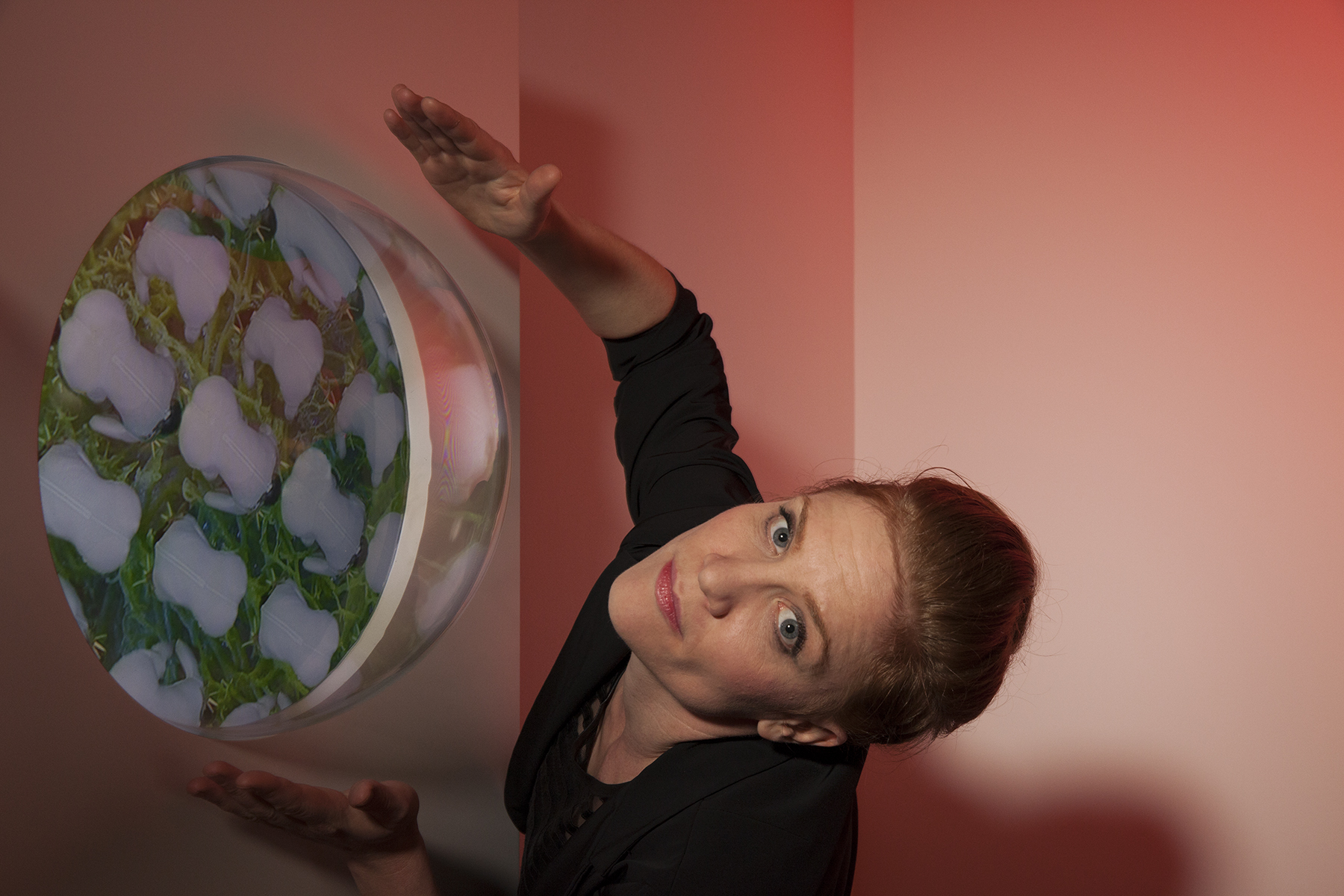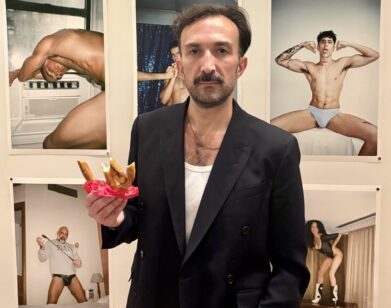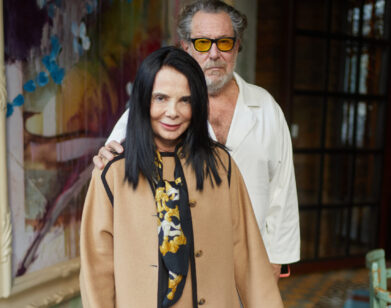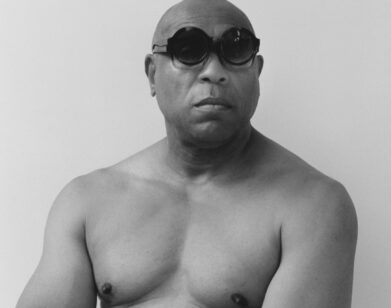Katja Loher’s Hive Mind
Did you know that butterflies are nearsighted, or that they taste with their feet? These are but a few interesting facts one can discover at “Bang Bang,” Swiss artist Katja Loher’s first solo show in New York. During the opening reception at C24 Gallery tomorrow, May 8, guests are encouraged to buzz around the newly revamped Chelsea space, along with a selection of Loher’s costumed performance artists, and directly engage with Loher’s elaborate mixed-media installation pieces. But Loher’s artwork is less interested in delivering factoids than it is concerned with posing difficult questions: Nine “portals,” featuring video projections of costumed dancers in synchronized Busby Berkeley-style, bird’s-eye-view choreography, spell out five unique questions respectively, ranging from subjects like humor and hope to abstract ponderings about existence and time.
Constructed in her Brooklyn studio—or video laboratory, as Loher calls it—the alluring wallflower portals contain their own micro-cosmos, precariously housed within custom blown glass bubbles and projected over boiling background cinematics. These petri-dish environments are created by filming various pulsing and bubbling liquids over an amplifier that churns out kaleidoscopic sound patterns in a shallow cauldron of bizarre primordial volatility. Loher’s creations implicitly urge her human viewers to shrink down to the level of insects, not only to empathize with these tiny but monumentally important creatures—which are vanishing at an alarming rate—but also to better comprehend the disastrous situation in which we’ve placed ourselves. The collective installation is an artistic feast, exciting all the senses.
We caught up with the insightful and well-traveled Loher, who speaks in a bouncing and playful Swiss accent, at C24 Gallery to discuss the daunting realities of Colony Collapse Disorder, the origins of her particular fascination with “video alphabets,” the allure of the mysterious “blue butterfly,” and finally, the death of cool and the birth of “Bang Bang.”
KURT MCVEY: You have such a pretty name. There’s a playful musicality to it.
KATJA LOHER: Thank you. My last name is Swiss, but my first name is originally Russian. That’s why it has the “J”. In Russia it would be something like Katjusha.
MCVEY: Are your parents artistic people?
LOHER: My mom is a teacher and my dad’s a doctor. So… [laughs] Though I would say I had a very artistic childhood. I grew up in Switzerland, in a small town next to Zurich. Thankfully, there was always plenty of room for my imagination.
MCVEY: What was your favorite season growing up?
LOHER: I don’t like the winter so much. I’ve always been more of a summer person.
MCVEY: Your show is opening at a very appropriate time of year. New York City is blooming all around us.
LOHER: It’s perfect, actually.
MCVEY: The work in “Bang Bang” touches on the disastrous effects we as humans have on our environment, whether it’s global warming or Colony Collapse Disorder. Did you build your rather elaborate artistic process around the message, or was it the other way around?
LOHER: I always start with the idea, or the message, and then I let it become its own creature. It forms in your head, matures in your heart, and then you watch it come alive. I tend to make beautiful things. Like a lot of nature, it’s just how I choose to communicate.
MCVEY: Are you a fan of Isabella Rossellini’s work?
LOHER: She is very interesting. I do love her Green Porno series. There are definitely some parallels with the creatures—the bees, the bats, and the butterflies. Also, there’s that low-tech element. We’re not trying to make it look real. It’s more about the performance.
MCVEY: Have you ever done synchronized swimming?
LOHER: [laughs] No, but I was actually just telling my assistants that I would like to try it for my next portal. It seems like fun.
MCVEY: Besides their important role in nature, what drew you to bees?
LOHER: Well besides being the most important pollinator—and we only have 50 percent of the normal population of bees left on the planet—I’m fascinated with bees because they communicate by dancing; and of course, the language used in my videos is dance.
MCVEY: Are you a trained dancer?
LOHER: No, but a lot of my friends are. I do my best to tell them what to do and they end up doing something much more spectacular. Their flexibility and body control amazes me. In fact, in 2006 I really wanted to make what I was calling a “video planet,” but I didn’t know how the hell I was going to do it. So I invited some friends over and climbed up to a roof—in Brooklyn actually—and shouted down at them in the backyard. It was the first time I did the video alphabet where dancers form letters, which then make words, which ultimately form questions. Even though it was a low-budget production, it turned out great. I had a lot of artist luck, as I like to say. Every artist needs artist luck.
MCVEY: There are a lot of elements and mediums involved in the portals. How hands-on are you in each particular step?
LOHER: There are so many steps involved in my work, and I do my best to be involved for each one—from the conceptual design to the costume-making, then to the actual shooting, which involves choreography and dance. There’s a lot of text involved and a lot of post-production with audio and video editing, as well as sculpting and glassblowing. I’m probably forgetting something. [laughs]
MCVEY: It sounds like a lot to manage. You’re as much of a director as you are an artist. I really appreciate directors, primarily because they appear to be, above all else, master collaborators.
LOHER: Totally.
MCVEY: What steps are being taken to slow or reverse Colony Collapse Disorder?
LOHER: I wish I had an answer for you. It’s so upsetting, because for so long they didn’t know what it is, or why it was happening, but it’s so clear.
MCVEY: I read recently that it’s the fungicides.
LOHER: No, no. It’s the pesticides, which in turn create the fungus that spreads through the hive. Nothing is being done. It’s the farming industry. It’s so sad really.
MCVEY: Can the individual do anything, or do we have to go after these major agricultural institutions?
LOHER: That’s the big question. It’s the same with global warming. The facts are in. We’re obviously destroying our planet, but the system makes it so hard to make changes, especially because the people who control the system aren’t necessarily interested in changing. It’s all money-related, of course. I believe in small changes. I believe in the miniverse, which has the potential to become a parallel universe. No matter how daunting the situation may be, we must continue to express these concerns as individuals. We also have to do our best to live in harmony with our environment. I hope to remind people that even the smallest creatures can make the greatest impact.
MCVEY: The butterfly effect, if you will.
LOHER: Exactly.
MCVEY: What’s your favorite butterfly?
LOHER: The blue ones in the rain forest. [laughs]
MCVEY: I’ll have to Google “the blue ones.” [laughs]
LOHER: I went on a trip through the rain forest in Peru and I asked my guide, “What’s the name of this butterfly?” He said, “Oh, that’s the blue butterfly.” [both laugh]
MCVEY: I almost forgot to ask; why “Bang Bang”?
LOHER: So “Bang Bang” is the start of a lot of things, actually. I’m working on a book for instance. This is the first big “Bang Bang” show. I want the title to express genuine excitement and surprise. My friends and I have been using it quite often lately. We’ll say, “This is so bang bang! He or she is totally bang bang!” There’s no better word for things I really like.
MCVEY: So “cool” no longer suffices. It’s not really cool unless it’s “bang bang.”
LOHER: I would say, use it in times when words escape or fail you. I want people to feel that when you see my art or any art for that matter that inspires or surprises you. I want you to see it and say, “Wow. That’s bang bang.”
MCVEY: Bang bang!
LOHER: [Laughs] You got it.
KATJA LOHER’S “BANG BANG” IS ON VIEW AT C24 GALLERY TOMORROW, MAY 8, THROUGH JUNE 21.







